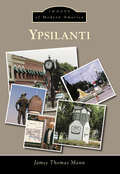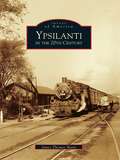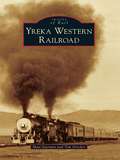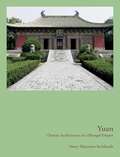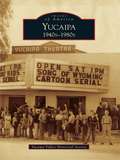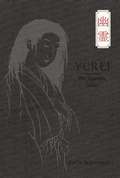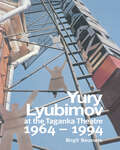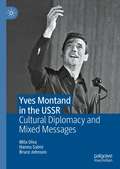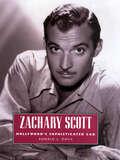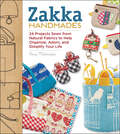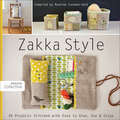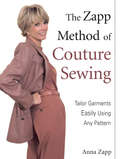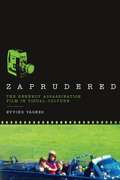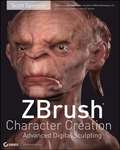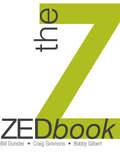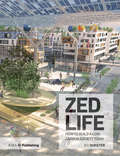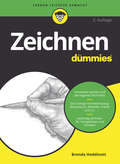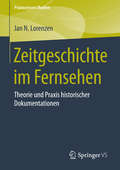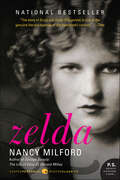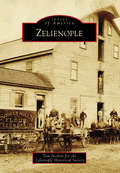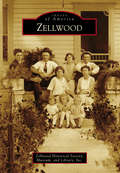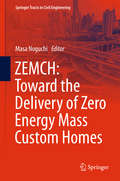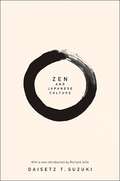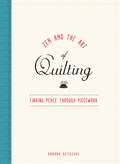- Table View
- List View
Ypsilanti: A History In Pictures (Images of Modern America)
by James Thomas MannYpsilanti, Michigan, home to Eastern Michigan University, is a small city where a great deal happens. This is a community with a strong sense of history and historic preservation. Homes and buildings about to fall in on themselves in the 1960s were preserved and restored and have found new uses today. It is a place of festivals, parades, concerts, and performances. There have been problems and turmoil, such as the time when the president of Eastern Michigan University needed a new house, but in each instance the people of Ypsilanti have come through stronger than before. Here, local historian James Mann shares why the people of Ypsilanti take pride in their city.
Ypsilanti in the 20th Century
by James Thomas MannFrom 1900 through 1975, the city of Ypsilanti underwent a multitude of changes as it developed from a small farming community into a center of education and business. The rise of the automobile and the insurgence of auto manufacturing, the progress of local arts and theater, the opening of the Bomber Plant at Willow Run, and the transformation of a teachers' college into Eastern Michigan University are just a few of these historic developments. This book, a companion to Ypsilanti: A History in Pictures, chronicles Ypsilanti's magnificent growth throughout the twentieth century, and the celebrated people, places, and events that helped shape the city as it is known today.
Yreka Western Railroad
by Matt Starman Tim StrickerThe city of Yreka was determined to have a railroad. When the Southern Pacific Railroad decided in 1883 to bypass Yreka, the citizens constructed their own railroad known as the Yreka Railroad Company. This railroad managed to eke out a living over the next few decades. In the 1930s, the railroad was reincorporated as the Yreka Western Railroad. By the mid-1930s, the railroad went bankrupt and was forced into receivership, and a new manager was put in charge. Through perseverance of the new manager, the railroad began to grow and prosper. By the late 1970s, the railroad once again started to decline, but as in the past, it managed to hold on. In 1986, the railroad started an excursion train known as the "Blue Goose," and steam locomotive No. 19 was added in 1989. Throughout all the hardships, the railroad still continues today and has been given the nickname "the Little Railroad that Refuses to Die."
Yuan: Chinese Architecture in a Mongol Empire
by Nancy SteinhardtA monumental illustrated survey of the architecture of thirteenth- and fourteenth-century ChinaThe Yuan dynasty endured for a century, leaving behind an architectural legacy without equal, from palaces, temples, and pagodas to pavilions, tombs, and stages. With a history enlivened by the likes of Khubilai Khan and Marco Polo, this spectacular empire spanned the breadth of China and far, far beyond, but its rulers were Mongols. Yuan presents the first comprehensive study in English of the architecture of China under Mongol rule.In this richly illustrated book, Nancy Shatzman Steinhardt looks at cities such as the legendary Shangdu—inspiration for Samuel Taylor Coleridge’s Xanadu—as well as the architecture the Mongols encountered on their routes of conquest. She examines the buildings and monuments of diverse faiths in China during the period, from Buddhist and Daoist to Confucian, Islamic, and Christian, as well as unusual structures such as observatories, archways, stone and metal buildings, and sarcophaguses. Steinhardt dispels long-standing views of the Mongols as destroyers of cities and architecture across Asia, showing how the khans and their families built more than they tore down. She demonstrates that the stipulations of the Chinese building system were powerful and resilient enough to guide the architecture that rose under Mongolian rule.Drawing on Steinhardt’s groundbreaking textual research in numerous languages as well as her pioneering fieldwork at sites across East Asia, Yuan will become the standard reference on this critical period of cultural and artistic exchange.
Yucaipa: 1940s-1980s
by Yucaipa Valley Historical SocietyWhen the soldiers returned after the end of World War II, the community of Yucaipa celebrated the victory and settled into a new era that would someday become known as the "good old days." Located in the foothills of the San Bernardino Mountains at the edge of the desert, the area and the climate was perfect for not only maintaining the agriculture-based economy, but establishing more businesses, churches, schools, and whole new neighborhoods. The first tracts of homes were followed with mobile home parks for new retirees looking for a real hometown, which they found in Yucaipa. People raised their children in a village-style environment, and the whole family could enjoy life with enthusiasm. There was plenty to do, and traditions that are continuing today were established in the form of parades, fairs, sports programs, and the enrichment opportunities of good schools, a college, and the community's love of its land and each other.
Yurei
by Zack Davisson"I lived in a haunted apartment." Zack Davisson opens this definitive work on Japan's ghosts, or yurei, with a personal tale about the spirit world. Eerie red marks on the apartment's ceiling kept Zack and his wife on edge. The landlord warned them not to open a door in the apartment that led to nowhere. "Our Japanese visitors had no problem putting a name to it . . . they would sense the vibes of the place, look around a bit and inevitably say 'Ahhh . . . yurei ga deteru.' There is a yurei here."Combining his lifelong interest in Japanese tradition and his personal experiences with these vengeful spirits, Davisson launches an investigation into the origin, popularization, and continued existence of yurei in Japan. Juxtaposing historical documents and legends against contemporary yurei-based horror films such as The Ring, Davisson explores the persistence of this paranormal phenomenon in modern day Japan and its continued spread throughout the West.Zack Davisson is a translator, writer, and scholar of Japanese folklore and ghosts. He is the translator of Mizuki Shigeru's Showa 1926-1939: A History of Japan and a translator and contributor to Kitaro. He also worked as a researcher and on-screen talent for National Geographic's TV special Japan: Lost Souls of Okinawa. He writes extensively about Japanese ghost stories at his website, hyakumonogatari.com.
Yuri Lyubimov: At The Taganka Theatre, 1964-1994
by B. BeumersA study of Yury Lyubimov's tempestuous career and his style of theatre during his thirty years at the Taganka Theatre. This work traces the development of his ideas, from his arrival at the theatre in 1964 through to his explusion in 1984, and his period of exile in the West until his return in 1989 to a much-changed Russia. Tracing Lyubimov's work play by play, the book uncovers an individual doomed to be at odds with the prevailing political and social climate of his literary contemporaries.
Yves Montand in the USSR: Cultural Diplomacy and Mixed Messages
by Mila Oiva Hannu Salmi Bruce JohnsonThis volume is the first book-length account of Yves Montand’s controversial tour of the Soviet Union at the turn of the years 1956/57. It traces the mixed messages of this internationally visible act of cultural diplomacy in the middle of the turbulent Cold War. It also provides an account of the celebrated French singer-actor’s controversial career, his dedication to music and to peace activism, as well as his widespread fandom in the USSR. The book describes the political background for the events of the year 1956, including the changing Soviet atmosphere after Stalin’s death, portrays the rising transnational stardom of Montand in the 1940s and 1950s, and explores the controversies aroused by his plan to visit Moscow after the Hungarian Uprising. The book pays particular attention to Montand’s reception in the USSR and his concert performances, drawing on unique archival material and oral history interviews, and analyses the documentary Yves Montand Sings (1957) released immediately after his visit.
Zachary Scott: Hollywood's Sophisticated Cad (Hollywood Legends Series)
by Ronald L. DavisThroughout the 1940s, Zachary Scott (1914-1965) was the model for sophisticated, debonair villains in American film. His best-known roles include a mysterious criminal in The Mask of Dimitrios and the indolent husband in Mildred Pierce. He garnered further acclaim for his portrayal of villains in Her Kind of Man, Danger Signal, and South of St. Louis. Although he earned critical praise for his performance as a heroic tenant farmer in Jean Renoir's The Southerner, Scott never quite escaped typecasting. In Zachary Scott: Hollywood's Sophisticated Cad, Ronald L. Davis writes an appealing biography of the film star. Scott grew up in privileged circumstances—his father was a distinguished physician; his grandfather was a pioneer cattle baron—and was expected to follow his father into medical practice. Instead, Scott began to pursue a career in theater while studying at the University of Texas and subsequently worked his way on a ship to England to pursue acting. Upon his return to America, he began to look for work in New York. Excelling on stage and screen throughout the 1940s, Scott seemed destined for stardom. By the end of 1950, however, he had suffered through a turbulent divorce. A rafting accident left him badly shaken and clinically depressed. His frustration over his roles mounted, and he began to drink heavily. He remarried and spent the rest of his career concentrating on stage and television work. Although Scott continued to perform occasionally in films, he never reclaimed the level of stardom that he had in the mid-1940s. To reconstruct Scott's life, Davis uses interviews with Scott and colleagues and reviews, articles, and archival correspondence from the Scott papers at the University of Texas and from the Warner Brothers Archives. The result is a portrait of a talented actor who was rarely allowed to show his versatility on the screen.
Zakka Handmades: 24 Projects Sewn from Natural Fabrics to Help Organize, Adorn, and Simplify Your Life
by Amy MorinakaLearn how to sew simple, clever things that organize your home and help with daily tasks with Zakka Handmades! These incredibly useful projects include pouches and bags, small toys and baby items, and handy kitchen accessories. Some of the author&’s sewn items also incorporate simple crochet. In Japanese, zakka means &“household goods,&” referring to items for domestic use—tableware, kitchenware, containers of various kinds, even simple clothing. What all the items have in common is a simple, fresh, handmade aesthetic; a subtle, clever wit; and absolute usefulness and practicality.
Zakka Style: 24 Projects Stitched with Ease to Give, Use & Enjoy (Design Collective)
by Rashida Coleman-HaleCreate charming fabric crafts inspired by the Japanese design movement that you can use to brighten up your home or give as gifts to friends.Discover the hottest new trend in fabric crafting—Zakka! These clever, modern projects are a cinch to sew using basic patchwork, appliqué, and embroidery. It’s scrap-friendly and fun for all sewing skill levels.Rashida Coleman-Hale has gathered talented designers from around the world to bring you 24 delightful Zakka projects. Zakka, a Japanese term meaning “many things,” is all about all the little things that improve your home and appearance. Create a one-of-a-kind picture frame, a stylish bread bag, a whimsical bookmark, a chic tote, and so much more. You’ll love these bright, imaginative designs-make them for yourself and everyone you know!Featuring contributions by Amanda Jennings, Amy Sinibaldi, Ayumi Takahashi, Christie Fowler, Holly Keller, Julia Bravo, Karyn Valino, Kat Mew, Katrien Van Deuren, Kim Kruzich, Larissa Holland, Laurraine Yuyama, Leslie Good, Lisa Billings, Masko Jefferson, Meg Spaeth, Melody Miller, Mette Robl, Nova Flitter, Pascal Mestdagh, Rachel Roxburgh, Shannon Dreval, Sonia Cantie, and Theresia Cookson.Award-Winner in the Crafts/Hobbies/How-To category of the 2012 International Book AwardsPraise for Zakka Style“The term “zakka” . . . has become synonymous with a kind of simple charm and uniqueness—something handmade that is useful and pleasing. . . . This book is another wonderful source for gift ideas and sweet little knick-knacks to make ‘just because.’” —Australian Homespun Magazine
The Zapp Method of Couture Sewing: Tailor Garments Easily Using Any Pattern
by Anna ZappSew Clothes that Fit Perfectly! Pants, jackets, vests, shirts ... No matter what garments you want to sew, or what pattern you buy, Anna Zapp will show you how to get a perfect fit. Learn fitting and sewing tricks that will save time and effort and help you sew clothes that rival the most expensive couture lines.
Zaprudered: The Kennedy Assassination Film in Visual Culture
by Øyvind VågnesAs the fiftieth anniversary of the Kennedy assassination approaches, the traumatic aspects of the tragedy continue to haunt our perceptions of the 1960s. One reason for this lies in the home movie of the incident filmed by Abraham Zapruder, a bystander who became one of the twentieth century's most important accidental documentarians. <P> The first book devoted exclusively to the topic, Zaprudered traces the journey of the film and its effect on the world's collective imagination. Providing insightful perspective as an observer of American culture, Norwegian media studies scholar Øyvind Vågnes begins by analyzing three narratives that are projections of Zapruder's images: performance group Ant Farm's video The Eternal Frame, Don DeLillo's novel Underworld, and an episode from Seinfeld. Subsequent topics he investigates include Dealey Plaza's Sixth Floor Museum, Zoran Naskovski's installation Death in Dallas, assassin video games, and other artifacts of the ways in which the footage has made a lasting impact on popular culture and the historical imagination. Vågnes also explores the role of other accidental documentarians, such as those who captured scenes of 9/11.
Zayn
by ZaynThe first and only official book from ZAYN. Global superstar ZAYN shares a photographic journey of his life since leaving One Direction. ZAYN opens up with this collection of thoughts, inspiration, and never-before-seen personal photographs. After five years of massive success with One Direction, ZAYN launched his career as a solo artist with Mind of Mine, becoming one of the most successful artists in the world. Now, for the first time ever, ZAYN is going to tell and show all in this intimate and raw scrapbook of his life. Never-before-released photos give readers insight to ZAYN, no-holds-barred. Gorgeously designed with hundreds of full-color photographs and ZAYN's notes, drawings, song lyrics, and personal stories, the book captures ZAYN's most private moments and his candid feelings on fame, success, music, and life. The next chapter of ZAYN's evolution into global superstar, told by the artist who is living it. *** Reviews for Mind of Mine: "A singer eager to reclaim the parts of himself that five years in the pop klieg lights forced into the shadows."--The New York Times "Sonically, you won't find many pop albums in 2016 more immaculately conceived than this."--SPIN "Sublime."--USA Today "Malik can sing . . . he's done this before, but not like this."--Rolling Stone "A moody, deeply textured R&B album..."--Los Angeles Times "Zayn has clearly achieved his aim of making an album of sexy, credible pop-R&B."--NMEFrom the Hardcover edition.
ZBrush Character Creation
by Scott SpencerZBrush's popularity is exploding giving more CG artists the power to create stunning digital art with a distinctively fine art feel. ZBrush Character Creation: Advanced Digital Sculpting is the must-have guide to creating highly detailed, lush, organic models using the revolutionary ZBrush software. Digital sculptor Scott Spencer guides you through the full array of ZBrush tools, including brushes, textures and detailing. With a focus on both the artistry and the technical know-how, you'll learn how to apply traditional sculpting and painting techniques to 3D art while uncovering the "why" behind the "how" for each step. You'll gain inspiration and insight from the beautiful full-color illustrations and professional tips from experienced ZBrush artists included in the book. And, above all, you'll have a solid understanding of how applying time-honored artistic methods to your workflow can turn ordinary digital art into breathtaking digital masterpieces.
The ZEDbook: Solutions for a Shrinking World
by Bill DunsterThough few now doubt the severity of the environmental problems faced by humanity there is still resistance from businesses, developers, architects, planners and government when it comes to making the step changes necessary to make our lifestyles sustainable. Based on the experience gained from their involvement in the pioneering Beddington Zero Emission Development (or BedZED) in London, and subsequent innovative schemes, The ZEDbook authors present a bold, coherent and refreshing vision of a low carbon future. In three comprehensive sections, The ZEDbook leads the reader from basic ZEDliving principles through building physics and architectural design details to a carefully selected array of informative case studies. The ZEDbook is a must-have purchase for anyone wanting to make communities and the built environment more sustainable.
ZEDlife
by Bill DunsterThe argument for low-cost, zero-energy, zero-waste architecture has never been timelier, while the mainstream has largely abandoned or neglected this agenda: in the UK the recent mandatory zero-carbon performance targets for new homes have been postponed or forgotten at a time when thousands of new homes will be built, and there is already a shortage of electric generating capacity. This book offers a forceful challenge to the current addiction to overconsumption of natural capital and energy, and provides workable, sustainable solutions for zero-carbon, zero-waste design.
Zeichnen für Dummies (Für Dummies)
by Brenda HoddinottImmer wieder ist es faszinierend, wie schnell manche Menschen die schönsten Zeichnungen auf Papier zaubern können. Ein paar Striche, Linien und auf wundersame Art und Weise entstehen Gegenstände, Landschaften und Gesichter. Sehr beeindruckend. »Zeichnen für Dummies« beginnt mit den Grundlagen und arbeitet sich dann zu immer komplexeren Darstellungen vor. Den Lesern wird systematisch erklärt, wie sie den Stift führen müssen, damit sie ihre Motive mit einem Schuss Persönlichkeit aufs Papier bringen können.
Zeitgeschichte im Fernsehen
by Jan N. LorenzenDer Band setzt sich mit den unterschiedlichen Erwartungshaltungen an Autoren und Regisseure historischer Dokumentation auseinander und entwickelt daraus einen Leitfaden für die Praxis. Welche dramaturgischen Grundmuster bieten sich für historische Dokumentationen an? Was ist ein angemessener Umgang mit Zeitzeugen im Spannungsfeld von subjektiver Wahrnehmung und historischer Wahrheit? Welche wissenschaftlichen Kriterien sind eher hinderlich, welche historischen Forschungsansätze können dagegen hilfreich sein? Anhand zahlreicher Beispiele erläutert der Autor, wie es gelingt, den unterschiedlichen Erwartungshaltungen zu entsprechen und dennoch den eigenen Gestaltungswillen nicht aus den Augen zu verlieren.
Zelda: A Biography
by Nancy Milford“Profound, overwhelmingly moving . . . a richly complex love story.” — New York TimesAcclaimed biographer Nancy Milford brings to life the tormented, elusive personality of Zelda Sayre and clarifies as never before Zelda’s relationship with her husband F. Scott Fitzgerald—tracing the inner disintegration of a gifted, despairing woman, torn by the clash between her husband’s career and her own talent.Zelda Sayre’s stormy life spanned from notoriety as a spirited Southern beauty to success as a gifted novelist and international celebrity at the side of her husband, F. Scott Fitzgerald. Zelda and Fitzgerald were one of the most visible couples of the Jazz Age, inhabiting and creating around them a world of excitement, romance, art, and promise. Yet their tumultuous relationship precipitated a descent into depression and mental instability for Zelda, leaving her to spend the final twenty years of her life in hospital care, until a fire at a sanitarium claimed her life.Incorporating years of exhaustive research and interviews, Milford illuminates Zelda’s nuanced and elusive personality, giving character to both her artistic vibrancy and to her catastrophic collapse.
Zelienople
by Zelienople Historical Society Tom NesbittIn 1800, Butler County had just been created and was nothing but forest, streams, and Indian trails. Dettmar Basse purchased 10,000 acres in this wilderness, where he hoped to create a barony similar to the ones he had known in Germany. In 1802, he started to build his Bassenheim (Basse's home). It took seven years and $7,000 to build this castle, and he also laid out streets for a town that he named for his daughter Zelie (nople means village). Zelie and her new husband, Philippe Passavant, of French ancestry, traveled here in 1807 and became the first merchants on Main Street. Their son William A. Passavant founded numerous orphanages and hospitals throughout the country. Christian Buhl, the hatter and furrier, came to Zelienople from Germany in 1802. His grandson Henry Buhl Jr. founded Boggs and Buhl Department Store on the north side of Pittsburgh. In 1927, he bequeathed an $11-million endowment to the Buhl Foundation, making it one of the best-funded foundations in the country.
Zellwood
by Zellwood Historical Society, Museum, and Library, Inc.Zellwood was named for Thomas Ellwood Zell, who arrived in the area in 1876. Zell sent scrapbooks displaying newspaper clippings to entice Northern friends--former Civil War officers--to settle near Lakes Maggiore and Minore. Word spread that Zellwood was a desirable place to winter and do business. Construction of millionaire steel magnate James Laughlin Jr.'s mansion began in 1885. Zellwood attracted people who built estates and new homes. Boardinghouses popped up. The Holly Arms Hotel and Zellwood Inn housed farmers, teachers, and entrepreneurs. In 1911, a train brought more settlers planning to earn their livelihood from Zellwood's rich earth. Agriculture dominated from the 1940s through the late 1990s. Zellwood was known for sweet corn. By 1999, all but one farm had been purchased for Lake Apopka restoration. Only Long and Scott Farms carries on the tradition of growing Zellwood sweet corn by farming the sandy soil bordering the muck lands of Lake Apopka.
ZEMCH: Toward the Delivery of Zero Energy Mass Custom Homes
by Masa NoguchiIn this book, leading international experts explore the emerging concept of the zero energy mass custom home (ZEMCH) - designed to meet the need for social, economic, and environmental sustainability - and provide all of the knowledge required for the delivery of zero energy mass customized housing and community developments in developed and developing countries. The coverage is wide ranging, progressing from explanation of the meaning of sustainable development to discussion of challenges and trends in mass housing, the advantages and disadvantages of prefabricated methods of construction, and the concepts of mass customization, mass personalization, and inclusive design. A chapter on energy use will aid the reader in designing and retrofitting housing to reduce energy demand and/or improve energy end‐use efficiency. Passive design strategies and active technologies (especially solar) are thoroughly reviewed. Application of the ZEMCH construction criteria to new buildings and refurbishment of old houses is explained and the methods and value of building performance simulation, analyzed. The concluding chapter presents examples of ZEMCH projects from around the world, with discussion of marketing strategy, design, quality assurance, and delivery challenges. The book will be invaluable as a training/teaching tool for both students and industry partners.
Zen and Japanese Culture
by Daisetz T. Suzuki Richard M. JaffeZen and Japanese Culture is one of the twentieth century's leading works on Zen, and a valuable source for those wishing to understand its concepts in the context of Japanese life and art. In simple, often poetic, language, Daisetz Suzuki describes his conception of Zen and its historical evolution. He connects Zen to the philosophy of the samurai, and subtly portrays the relationship between Zen and swordsmanship, haiku, tea ceremonies, and the Japanese love of nature. Suzuki's contemplative work is enhanced by anecdotes, poetry, and illustrations showing silk screens, calligraphy, and examples of architecture. Since its original publication in 1938, this important work has played a major role in shaping conceptions of Zen's influence on Japanese traditional arts. Richard Jaffe's introduction acquaints a new generation of readers with Suzuki's life and career in both Japan and America. Jaffe discusses how Zen and Japanese Culture was received upon its first publication and analyzes the book in light of contemporary criticism, especially by scholars of Japanese Buddhism.
Zen and the Art of Quilting
by Sandra DetrixheBring balance to your life in the marriage of beauty and function!From selecting fabrics to threading the needle to piecing together your project, the steps you take to create a beautiful quilt will allow you to calm your mind and bring harmony to your life. Master quilter Sandra Detrixhe shares what she's learned through years of creating art out of scraps of cloth: Quilting is a type of meditation. It's both absorbing and mind-freeing. Sandra and several of her colleagues relate stories about the quiet, mindful experience of quilting--choosing fabrics with a purpose in mind, adding pieces with special meaning, and finding a community of quilters.Each chapter includes a suggested activity that will show you how to find peace in the process. You'll soon be able to turn every minute you spend patterning, basting, and binding into enjoyable, mindful moments. With Zen and the Art of Quilting, you'll learn your wonderful, handmade quilt isn't the craft's only reward. The meditative practice of making your lovely new piece is something to be treasured as well.
